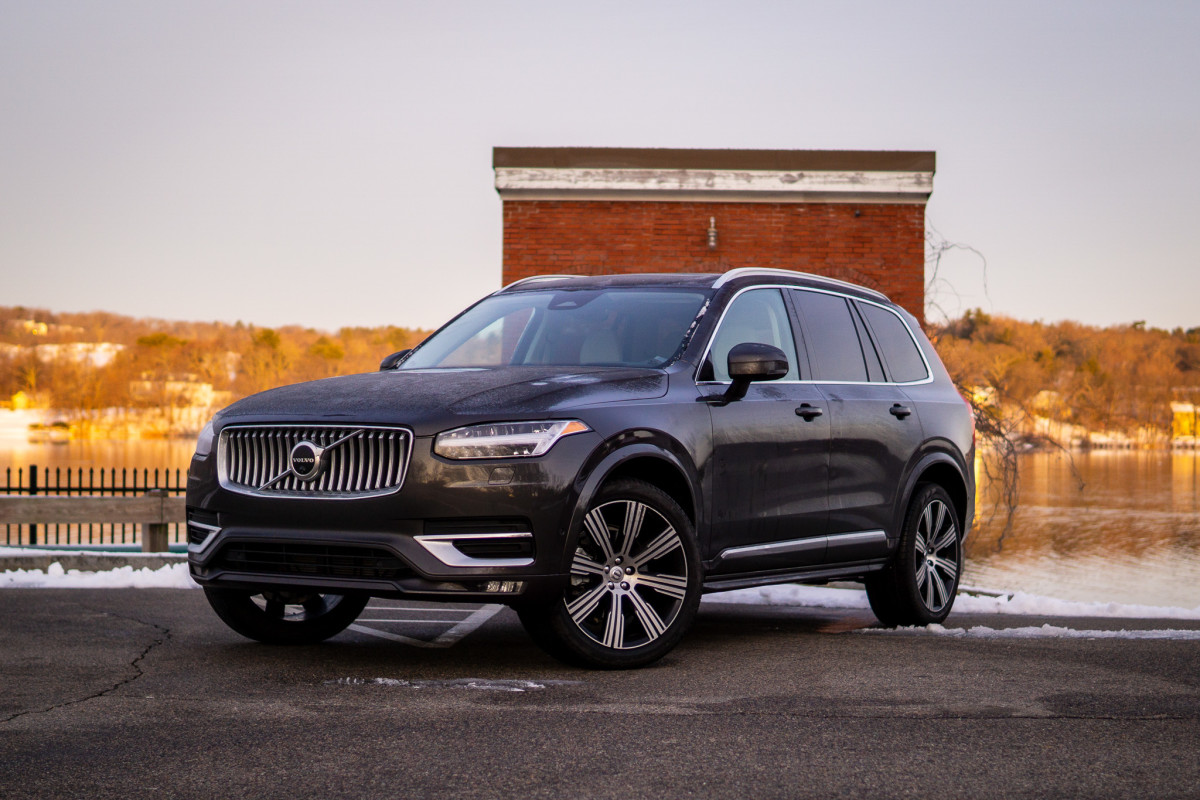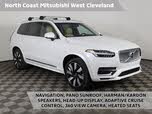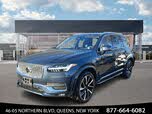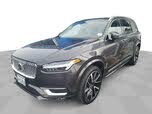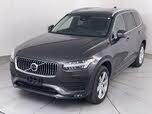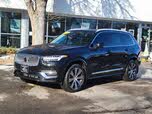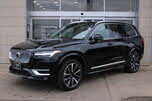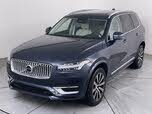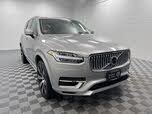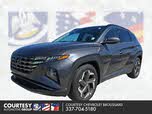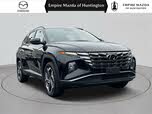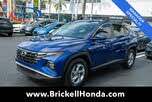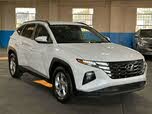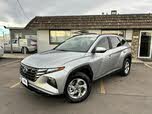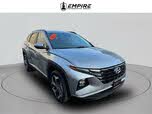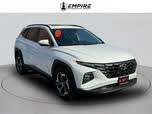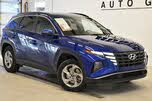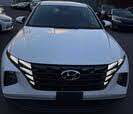2023 Volvo XC90 vs 2022 Hyundai Tucson
Overview | ||
MSRP | $25,800 | $56,000 |
Average price | $22,998 | $46,904 |
Listings | ||
Ratings & Reviews | ||
User reviews | ||
Expert reviews | 8.3 out of 10Read full review | 8.0 out of 10Read full review |
Pros & cons | Pros
| Pros
|
Summary | The redesigned 2022 Hyundai Tucson has to offer a high-tech cabin, comfortable ride, competent engine lineup, and spacious cargo area to keep up with the Joneses in the hot-selling and competitive compact SUV class. It does that, and more, with Hyundai giving plenty of compelling reasons to take the 2022 Tucson for a test drive. | In sophisticated circles, the XC90 can feel like an old friend. Its design has evolved subtly over the past twenty years, making it recognizable without looking old. For 2023, the XC90’s powertrains have evolved, too. Out with the T5 and T6 engines, in with the B5 and B6 mild-hybrid powertrains. Finally, Google lovers will absolutely want to investigate the new XC90’s forward-thinking infotainment technology. |
Video | ||
Popular Features & Specs | ||
Engine | 2.5L 187 hp I4 | 2.0L 247 hp I4 |
Drive Train | FWD | AWD |
Seating Capacity | 5 | 7 |
Horsepower | 187 hp @ 6100 rpm | 247 hp @ 5500 rpm |
MPG City | 26 | 22 |
MPG Highway | 33 | 28 |
Engine | ||
Engine Name | 2.5L 187 hp I4 | 2.0L 247 hp I4 |
Torque | 178 lb-ft @ 4000 rpm | 258 lb-ft @ 1500 rpm |
Horsepower | 187 hp @ 6100 rpm | 247 hp @ 5500 rpm |
Drivetrain | FWD | AWD |
Fuel Economy | ||
MPG City | 26 | 22 |
MPG Highway | 33 | 28 |
Interior | ||
Seating Capacity | 5 | 7 |
Key Features | ||
Navigation System | Standard | |
Sunroof/Moonroof | Standard | |
Safety | ||
Front Crash Overall | 5 | 5 |
Side Crash Overall | 5 | 5 |
Dimensions & Capacity | ||
Cargo Space | 38.7 cu ft | 15.8 cu ft |
Curb Weight | 3329 lbs | 4589 lbs |
Height | 65.6 in | 69.9 in |
Length | 182.3 in | 195.0 in |
Width | 73.4 in | 84.3 in |
Wheelbase | 108.5 in | 117.5 in |
Maximum Payload | 1301 lbs | 1210 lbs |
Number of doors | 4 | 4 |
Maximum Towing Capacity | 2000 lbs | 5000 lbs |
Standard Towing Capacity | 2000 lbs | |
The 2022 Hyundai Tucson rode on a new platform that featured exclusively a long-wheelbase model for the U.S. market. This expanded cargo area housed just two rows of seating. Up front, the Tucson sported the new face of Hyundai vehicles, sharing similarities with the Santa Cruz truck. The parametric grille concealed standard LED daytime running lights, Bi-LED headlights, and LED front turn signals, making them form a shape reminiscent of the Aztec Spirit Bird when illuminated.
The side profile was similar to that of the Hyundai Elantra, featuring a silver D-pillar that connected the window surrounds to the SUV's rear, creating a floating roof effect. The rear included toothy taillights illuminated by LEDs, except on the base model, helping the Tucson stand out in the compact SUV segment.
Wheel choices included 17- or 19-inch options, depending on the trim. The SE, SEL, and Blue trims came with 17-inch alloys, while the SEL trim with the Convenience Package upgraded to 19-inch alloys. There were four distinct wheel designs, including a darker, more complex option for the Tucson N-Line trim. High-end trims boasted premium fascias, front and rear skid plates, gloss black pillars, and a panoramic sunroof.
The Tucson's exterior was further enhanced with features like roof rails (excluding the SE trim), body-color side mirrors, solar glass, and acoustic laminated glass. Higher trims added heated outside mirrors with blind-spot monitoring and rear cross-traffic avoidance assist indicators, front aero wipers, and optional sunroofs.
Inside, the Tucson's cabin was well-appointed. Standard stain- and odor-resistant cloth seats were provided, while sport combination and leather-trimmed seats were available on the N-Line and Limited trims, respectively. Soft- and hard-touch surfaces gave the interior an upscale feel compared to its price point. Horizontal lines across the dashboard and an uncluttered design contributed to a sense of spaciousness.
In contrast, the 2023 Volvo XC90 embodied a shift from the brand's historical “rolling bricks” to a modern, purposeful design. With a stout and solid front end, the XC90's grille was assertive and bold without being flashy. The Thor’s Hammer design of the headlights added a modern flair. The overall dimensions still leaned towards a rectilinear shape but no longer evoked the image of a toaster.
Our test vehicle—a Platinum Gray AWD Ultimate trim—featured 21-inch wheels with low-profile Pirelli Scorpion all-season tires, adding drama to the vehicle's look. The Platinum Gray paint had brown undertones, giving it richness and depth under sunlight. Volvo’s paint palette remained muted, with shades of black, white, off-white, silver, and a smoky blue among the options.
The interior design of the XC90 was sleek and extremely elegant. It included a two-tone leather-wrapped steering wheel and a mix of luxurious materials such as Nappa leather upholstery and metal Bowers and Wilkins speaker covers. Orrefors crystal shift knobs added a touch of luxury. Interior color choices were “charcoal” or “blond” leather, with wood deco inlays across the dash and center console adding a hint of nature.
Overall, the XC90's cabin was beautifully clean and minimalist, though it provided limited physical controls, lending to a highly elegant yet simple aesthetic.
For the 2022 Hyundai Tucson, two powertrain options were available. The base engine was a 2.5-liter direct-injected four-cylinder paired with an eight-speed automatic transmission, delivering 187 horsepower and 178 pound-feet of torque. Although capable, it wasn't particularly inspiring, improving slightly in power over the previous generation's 2.4-liter engine.
More impressive was the hybrid variant, featuring a 1.6-liter turbocharged four-cylinder engine paired with a six-speed automatic transmission, producing a combined 226 horsepower and 258 pound-feet of torque. This powertrain was more engaging and fun to drive. In off-road testing, the Tucson’s AWD system performed admirably on loose gravel roads, akin to Subaru’s reactive AWD system.
Fuel efficiency was a strong point. The front-wheel-drive ICE Tucson achieved an EPA-estimated 26 mpg in the city, 33 mpg on the highway, and 29 mpg combined. AWD models saw a slight drop. The hybrid models shone with 37 mpg combined, outperforming several competitors. A plug-in hybrid was announced, offering an estimated total system output of 261 horsepower, but range specifics were still forthcoming.
In the case of the 2023 Volvo XC90, Volvo replaced its older turbocharged engines (T5 and T6) with B5 and B6 engines that incorporated mild-hybrid technology. The purpose was to improve fuel efficiency and smooth operation rather than boost horsepower. Both powertrains retained a 2.0-liter four-cylinder engine as their base.
The B5 engine produced 247 horsepower and 258 pound-feet of torque with the help of a turbocharger and mild-hybrid system. The more powerful B6 engine generated 295 horsepower and 310 pound-feet of torque, thanks to a supercharger, turbocharger, and mild-hybrid tech. Although not full hybrids, these engines benefited from a 48-volt mild-hybrid system that used an electric generator to manage ignition and climate control, enhancing fuel efficiency slightly and providing almost imperceptible auto stop-start functionality.
With its eight-speed automatic transmission, the XC90 delivered a smooth and enjoyable drive. Its large dimensions did not hinder cornering performance due to minimal body roll, thanks to its big wheels and thin tires. The ride was quiet, and the brakes inspired confidence with their reliable pedal feel. Although it lacked multiple drive modes or advanced off-road features, its performance in a New Hampshire snowstorm showcased its capabilities.
The 2022 Hyundai Tucson, a budget-friendly compact SUV, did not skimp on interior quality. Competing with the likes of the Toyota RAV4, Honda CR-V, Nissan Rogue, and Ford Escape, it matched or exceeded the competition in terms of interior appointments. A six-way power-adjustable driver's seat was standard, with an eight-way version available on higher trims. Heated front seats, ventilated front seats, memory for the driver’s seat, and an eight-way passenger seat were also options.
The tilt and telescoping steering wheel was standard, leather-wrapped in higher trims, and heated in the Limited variant. The new platform enabled a more spacious interior than ever, offering more headroom and legroom, particularly 2 inches more rear-seat legroom compared to the RAV4. The cabin comfortably accommodated a family of four, with cargo volume outpacing key rivals. The 74.8 cubic feet of cargo space was comparable to the Forester, RAV4, and CR-V and significantly better than the Escape’s cargo capacity. A 60-40 split-folding rear bench seat and a dual-level cargo floor added to its practicality.
The 2023 Volvo XC90’s front seats offered a pleasant and peaceful experience typical of Volvo’s Scandinavian minimalism, but storage space was lacking. There was no dedicated spot for a cell phone, and the USB port for connection was inside a small center console. The second row was comfortable and spacious but adjusting the seats was challenging. The standard seven-passenger model could be tailored to a six-passenger version with captain’s chairs for an additional $500 and an engine upgrade.
With the third-row seats in use, the XC90 offered 12.5 cubic feet of cargo space. Folding them down expanded capacity to 41.8 cubic feet, and with all rear seats folded, it maxed out at 65.5 cubic feet—a number that trailed behind the Audi Q7, Infiniti QX60, Genesis GV80, and Acura MDX. Despite its slightly smaller size than typical three-row SUVs, the XC90’s driving dynamics were commendable.
Hyundai equipped the 2022 Tucson with robust standard tech features. An 8-inch touchscreen infotainment system, a six-speaker audio system, wireless Apple CarPlay and Android Auto, HD Radio, and two USB ports were standard. The driver had a 4.2-inch multi-information display. Stepping up to the SEL/Blue trim added satellite radio, Blue Link app compatibility, extra USB outlets, rear air conditioning vents, and dual-zone automatic climate control.
Higher trims offered a 10.25-inch touchscreen with a tradeoff: wired Apple CarPlay and Android Auto. The design of the integrated climate control and radio/media functionality within the larger screen posed usability challenges. The responsiveness was better than early similar technologies from other brands, but the sleek steering wheel controls were less user-friendly.
The 2023 Volvo XC90’s tech offering was distinguished by its 9-inch vertical touchscreen running Google OS, the first of its kind. Google Maps and Google Assistant were built-in, with additional features like Google Home integration. The 12.3-inch driver information display added versatility.
While Google OS impressed with natural language recognition, Volvo’s reliance on screen-based controls for several functions could be frustrating. Adjusting heated features or seat positions required navigating the touchscreen, which some drivers might find inconvenient despite the system’s advanced capabilities.
The 2022 Hyundai Tucson had not yet been rated by IIHS or NHTSA. However, it came with a comprehensive Hyundai SmartSense suite that included features like forward collision-avoidance assist, lane-keep assist, automatic high beams, and more. Optional features included blind-spot warning, rear cross-traffic alert, adaptive cruise control, and parking collision avoidance. Hyundai offered strong warranties, including a 10-year/100,000-mile powertrain limited warranty and a 5-year/60,000-mile new vehicle limited warranty.
The 2023 Volvo XC90 excelled in safety, reflecting the brand’s legacy with the three-point seatbelt invention. It earned a five-star rating from NHTSA and the Top Safety Pick+ from IIHS. The standard safety suite included adaptive cruise control, lane-keeping assist, and Pilot Assist technology, providing confident handling in various driving conditions.
CarGurus highlights

According to CarGurus experts, the overall rating for 2022 Hyundai Tucson is 8.3 out of 10, while the 2023 Volvo XC90 scores 8 out of 10. The 2022 Hyundai Tucson stands out for its excellent balance of affordability, fuel efficiency, and spacious interior without compromising on tech and safety features. Thus, for those in search of a well-rounded, budget-friendly compact SUV, the Hyundai Tucson comes highly recommended.
Choose the 2023 Volvo XC90 if:
Shop Now- You value cutting-edge safety features and high safety ratings.
- You appreciate a luxurious and minimalist interior with advanced tech integration.
- You want a refined driving experience with robust mild-hybrid powertrains.
Choose the 2022 Hyundai Tucson if:
Shop Now- You prioritize excellent fuel efficiency and advanced hybrid options.
- You’re looking for a compact SUV with ample cargo space and comfortable passenger room.
- You desire a well-appointed interior with practical tech features and competitive pricing.

By: CarGurus + AI
At CarGurus, our team of experienced automotive writers remain at the heart of our content operation, conducting hands-on car tests and writing insightful guides that are backed by years of industry experience. To complement this, we are harnessing AI to make our content offering more diverse and more helpful to shoppers than ever. To achieve this, our AI systems are based exclusively on CarGurus content, ratings and data, so that what we produce is both unique to CarGurus, and uniquely helpful to car shoppers.
